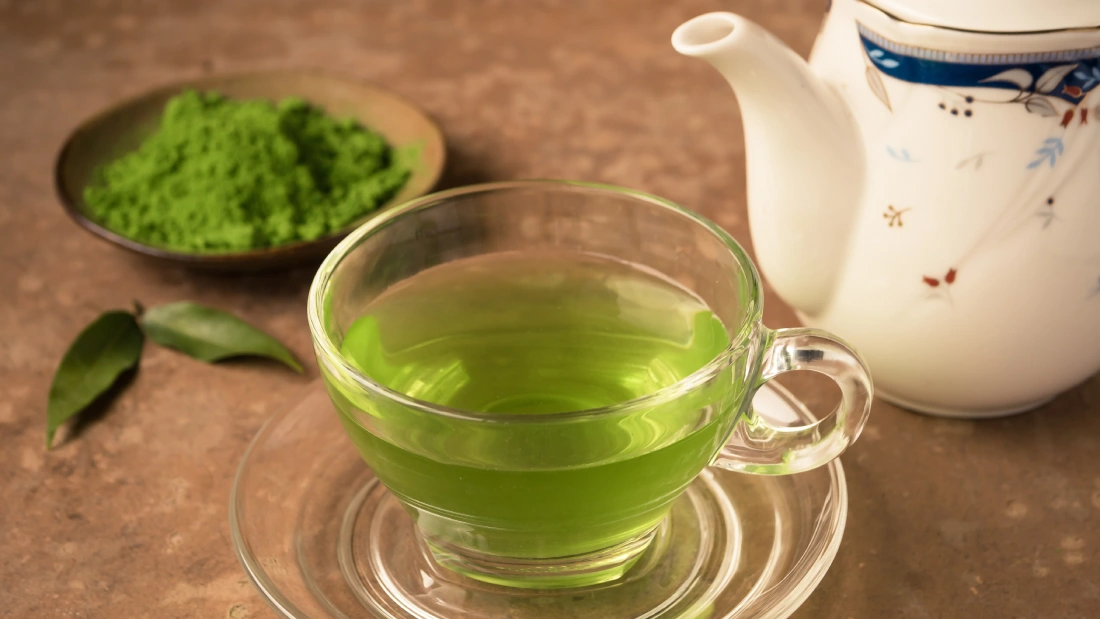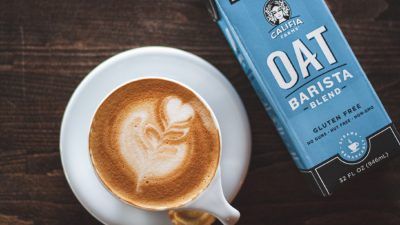10 ways to supercharge a healthy vegan diet

Ever wondered what’s the healthiest version of already healthy foods? Wonder no more! All of the foods below can be part of a healthy diet, but if you’re looking to power-up your plate, here are 10 ways you can go from healthy to healthiest.
1. Swap white potatoes for sweet potatoes
As with all foods in this list, white potatoes can be part of a healthy diet but sweet potatoes are an even healthier option. Sweet potatoes and white potatoes contain similar amounts of protein, fat and carbohydrates but 100 grams of sweet potato contains 100 per cent of our daily vitamin A requirements, whereas white potatoes contain hardly any. You need vitamin A for healthy skin and mucus membranes – the protective layers that line parts of your ear, nose, throat, digestive tract etc. It’s also very important for your immune system, eye health and vision.
Sweet potatoes also contain more fibre and have a lower glycemic index than white potatoes, meaning they don’t cause your blood-sugar to rise quite so quickly. Don’t write off white potatoes entirely though – they still have good amounts of vitamin C and other beneficial compounds. And let’s face it, nothing beats vegan bangers and mash!
2. Replace green peppers with red peppers
Green and red peppers are the same plant but green peppers are picked before the pepper has a chance to turn yellow, orange and finally red. Because red peppers have been left on the vine for longer, they are the most nutritious option.
Red peppers contain nearly nine times more vitamin A than green peppers, nearly five times as much folate and double the vitamin C. Their natural sweetness also makes them much easier to snack on than the more bitter green pepper. Don’t ignore the green ones though as they are richer in some antioxidants and vitamin K, needed for healthy blood clotting.
3. Swap spinach for kale
Popeye might have given spinach the best marketing campaign but kale is the king of calcium! Kale contains 250 milligrams of calcium per 100 grams compared to 100 milligrams per 100 grams of spinach – more than double.
Spinach is also high in oxalates – a compound that hinders our body’s ability to absorb the calcium from the spinach, and can also lead to kidney stones if eaten in excess or in people with existing kidney problems. Kale, on the other hand, is very low in oxalates meaning its calcium is more easily absorbed and it doesn’t pose the same risk to our kidneys. However, spinach does trump kale in terms of vitamin A, folate and vitamin K – just don’t eat handfuls every day.
4. Swap soya mince for brown lentils
There’s nothing unhealthy about soya – in fact it’s very good for you, unless you have an allergy. But, if you’re following a plant-based diet, chances are you’re already consuming quite a lot of healthy soya, in the form of soya milk, yoghurt, tofu and tempeh and processed soya mince tends to contain higher levels of fat and salt than these foods. Therefore, if you’re a fan of soya mince in dishes like chilli and spag bol, you might want to swap it for brown lentils instead.
Brown lentils make an excellent mince alternative and what’s more they’re highly nutritious. Lentils are a great source of protein, complex carbohydrates (including fibre), vitamins and minerals. They also contain natural phenolic compounds and carotenoids that are responsible for their colour but are also powerful antioxidants and have anti-inflammatory properties. Brown, black and red colours mean significantly more of these than pale-coloured lentils, such as yellow. These pigments and their health-protective properties have been linked to a lower risk of cardiovascular disease, type 2 diabetes and even cancer.

5. Forgo the fruity plant-based yoghurt for a plain one with fresh fruit
Whether for breakfast, lunch or dessert, yoghurts are yummy! Unfortunately, many pre-made fruity yoghurts are also very high in sugar. Some brands, such as Alpro, offer “no added sugar” fruity yoghurts but it’s a limited choice. An even better option would be to buy a plain, sugar-free yoghurt and add your favourite fresh fruit. This way you can choose the ones packed with the most nutrients, such as blueberries, blackberries, strawberries and apples.
6. Swap fruit juice for a homemade smoothie
Although fruit juice gets a bad rep because of all the free and sometimes added sugar it contains, it’s not quite as bad as chugging a can of fizzy pop, due to the fact that it also contains vitamins, micronutrients and polyphenols. There is evidence that fruit juice consumption may be a source of nutrition for those who do not eat much fresh fruit and veg, may reduce blood pressure, inflammation and the risk of stroke.
However, juice only ever counts as one of your 5-a-day and there is a healthier way to drink your fruits – and that’s a homemade smoothie. Unlike juice, a smoothie contains the whole fruit – the pulp, the skin, and the seeds. Yes, smoothies still raise blood sugar but a 2022 study found that when blackberries were included in the smoothie, the glycaemic response was actually lower for the blended fruit than the whole fruit! The researchers hypothesised that this could have been due to the “dietary fibre and nutritive components from ground blackberry seeds.” The great thing about a homemade smoothie is you can add your favourite fruits and vegetables and invent your own creative concoctions and as for your 5-a-day, you can add up and include all the fruit you used!
7. Trade mock meats for tofu
Mock meats make a great substitute for animal products, but so does tofu once you know how to make it delicious (check out Vegan Recipe Club for some tofu-rrific recipes). Don’t be fooled: tofu doesn’t have to be mushy and bland. For example, a block of spiced or marinated tofu, fried until golden and crispy can make a mouthwatering addition to sandwiches, curries and poke bowls. It can even make very convincing to-fish ‘n’ chips.
Tofu is a healthier option because it contains all the essential amino acids (protein building blocks) which the human body needs and is higher in protein than other pulses. It also supplies essential polyunsaturated fats (omega-3 and -6), fibre and is an excellent source of disease-busting antioxidants, B vitamins and iron. Calcium-set tofu provides substantial amounts of this important mineral for bone health.
8. Swap salt for nutritional yeast
We all know by now that too much salt is bad for our health. It can raise blood pressure, contribute to heart attacks and strokes and can also lead to calcium loss from our bones. It’s hard to control how much salt we consume when we eat out – it’s probably more than we’d like – but we can control how much we eat at home and a great way to reduce our salt consumption is to swap it for nutritional yeast (aka “nooch”). .
With its distinctive cheesy taste, nutritional yeast is the perfect companion to any savoury meal – sprinkle it on pasta, risotto, roast potatoes; stir into soups, spreads and sauces; or simply use it as a seasoning on fries and popcorn. Nutritional yeast is packed full of B vitamins (except B12 unless fortified), a good source of protein and high in fibre. It deserves a place in everyone’s pantry!
9. Replace sunflower oil with rapeseed or olive oil
Despite seed oils receiving a lot of bad press from some dietary tribes, there is nothing inherently unhealthy about them when consumed in moderation. However, one downside to many seed and vegetable oils is that they are particularly high in linoleic acid (LA) – an omega-6 fat. LA has health-promoting properties when consumed in moderation but most people get too much omega-6 fat in their diet and too little omega-3, which can lead to inflammation and other chronic diseases.
However, not all oils are equal and rapeseed has a much better omega-3 to omega-6 fatty acid ratio than sunflower oil. Rapeseed oil also has many other health benefits. Other oils lower in omega-6 include walnut, flaxseed and extra virgin olive oil.
10. Give green tea a go
We’re not here to deprive you of your preferred morning kickstarter, whether that’s a fancy filter coffee or a cup of builder’s tea, but you’re missing a trick if you don’t make room for some green tea. Both coffee and black tea have their own benefits, but green tea or matcha (powdered green tea), is the greatest of all time when it comes to its powerful health benefits.
Green tea is richer in antioxidants than other forms of tea and has been linked to a wide range of health benefits. The main antioxidants in green tea – known as catechins – have anti-inflammatory and anticancer properties, having been shown to play a role in the prevention of many cancers, including lung, breast, oesophageal, stomach, liver and prostate cancer. The antioxidants also reduce skin ageing and lower risk of neurodegenerative diseases, including Alzheimer’s. It’s time to go green!

All of the foods above can be part of a healthy diet and we should aim to eat as wide a variety of healthy, colourful foods as we can. If you build a varied plant-based diet around these foods, you won’t go wrong. Next time you’re in the supermarket or fruit and veg shop why not play a game of picking the healthiest produce?!







